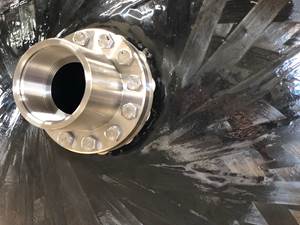NASA announces two winners in “space taxi” competition
NASA reported on Sept. 16 that it has selected The Boeing Co. (Houston, Texas) and SpaceX (Hawthorne, Calif.) to develop spacecraft to transport U.S. crews to and from the International Space Station (ISS).
NASA reported on Sept. 16 that it has selected The Boeing Co. (Houston, Texas) and SpaceX (Hawthorne, Calif.) to develop spacecraft to transport U.S. crews to and from the International Space Station (ISS). Boeing was the big winner, awarded $4.2 billion to develop its CST-100 spacecraft (pictured here, near right). SpaceX was awarded a smaller amount, $2.6 billion, to develop its Crew Dragon spacecraft. Sierra Nevada Corp. (SNC, Sparks, Nev.) and its Space Shuttle-like crew ship (far right), the Dream Chaser, was eliminated.
The U.S. has not had a spacecraft of its own available to transport U.S. crews to the ISS since the Space Shuttle fleet was retired in July 2011. Since then, NASA has relied on Russian-built craft to ferry its astronauts for space station duty. NASA administrator Charlie Bolden says, “Thanks to the leadership of President Obama, the hard work of our NASA and industry teams, and support from Congress, today we are one step closer to launching our astronauts from U.S. soil in American spacecraft and ending the nation’s sole reliance on Russia by 2017. Turning over low-Earth orbit transportation to private industry will also allow NASA to focus on an even more ambitious mission — sending humans to Mars.”
These Commercial Crew Transportation Capability (CCtCap) contracts are designed to complete the NASA certification for human space transportation systems capable of carrying people into orbit. The contracts with Boeing and SpaceX include at least one crewed flight test per company with at least one NASA astronaut aboard to verify that the fully integrated rocket and spacecraft system can launch, maneuver in orbit and dock to the space station and confirm that systems perform as expected. If and when each company’s test program is completed successfully, it will conduct at least two to as many as six crewed missions to the space station. These spacecraft also will serve as a lifeboat for astronauts aboard the station.
NASA’s Commercial Crew Program will implement this capability as a public/private partnership. The U.S. missions to the ISS will allow the station’s current crew of six to grow, enabling its members to conduct more research aboard the unique microgravity laboratory aboard the ISS. The companies will own and operate the crew transportation systems and be able to sell human space transportation services to other customers in addition to NASA, thereby reducing the costs for all customers.
In the wake of NASA’s announcement, Sierra Nevada laid off 90 employees at its Denver, Colo.-area facility, and announced on Sept. 26 that it has filed a formal legal challenge to the decision. Sierra Nevada noted in its press release that it had never before filed a legal challenge to a government contract award, but believes there are serious questions about, and evidence of inconsistencies in, the source selection process. The company also indicated it is continuing its efforts on a number of commercial and international partnerships with other space agencies and organizations. A company spokesperson also confirmed that a decision has been made to continue the development of the Dream Chaser through to flight readiness.
Related Content
Infinite Composites: Type V tanks for space, hydrogen, automotive and more
After a decade of proving its linerless, weight-saving composite tanks with NASA and more than 30 aerospace companies, this CryoSphere pioneer is scaling for growth in commercial space and sustainable transportation on Earth.
Read MoreCombining multifunctional thermoplastic composites, additive manufacturing for next-gen airframe structures
The DOMMINIO project combines AFP with 3D printed gyroid cores, embedded SHM sensors and smart materials for induction-driven disassembly of parts at end of life.
Read MoreDevelopment of a composite liquid hydrogen tank for commercial aircraft
Netherlands consortium advances cryogenic composites testing, tank designs and manufacturing including AFP, hybrid winding, welding of tank components and integrated SHM and H2 sensors for demonstrators in 2025.
Read MoreOtto Aviation launches Phantom 3500 business jet with all-composite airframe from Leonardo
Promising 60% less fuel burn and 90% less emissions using SAF, the super-laminar flow design with windowless fuselage will be built using RTM in Florida facility with certification slated for 2030.
Read MoreRead Next
Cutting 100 pounds, certification time for the X-59 nose cone
Swift Engineering used HyperX software to remove 100 pounds from 38-foot graphite/epoxy cored nose cone for X-59 supersonic aircraft.
Read MoreCeramic matrix composites: Faster, cheaper, higher temperature
New players proliferate, increasing CMC materials and manufacturing capacity, novel processes and automation to meet demand for higher part volumes and performance.
Read MoreScaling up, optimizing the flax fiber composite camper
Greenlander’s Sherpa RV cab, which is largely constructed from flax fiber/bio-epoxy sandwich panels, nears commercial production readiness and next-generation scale-up.
Read More











